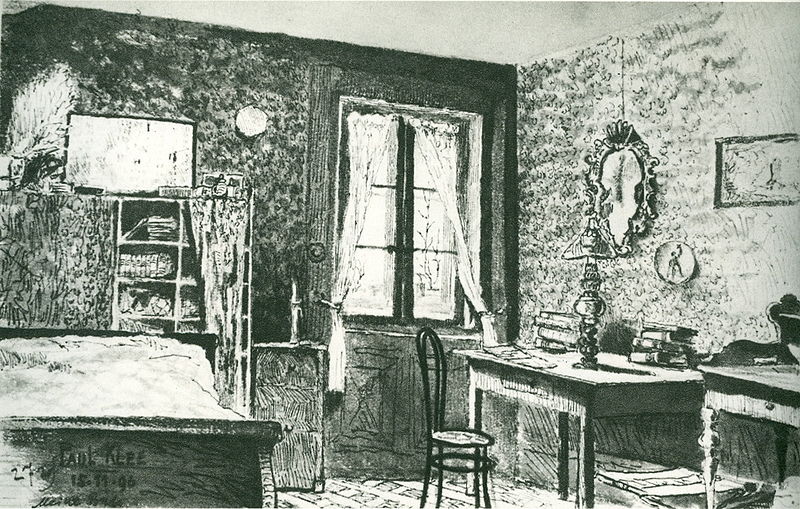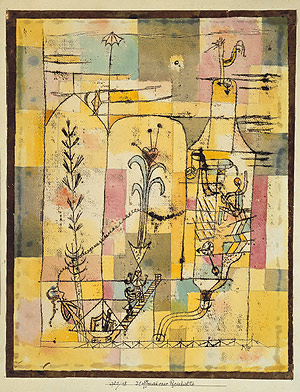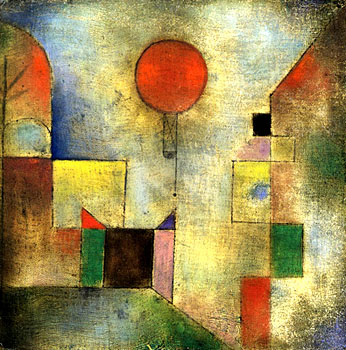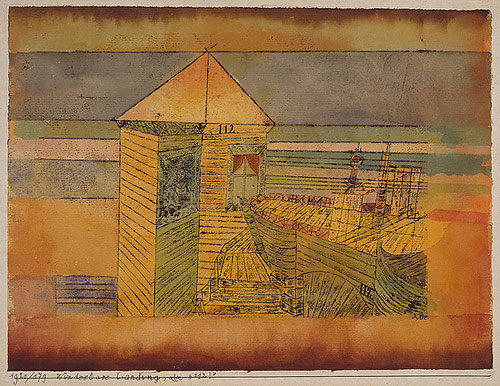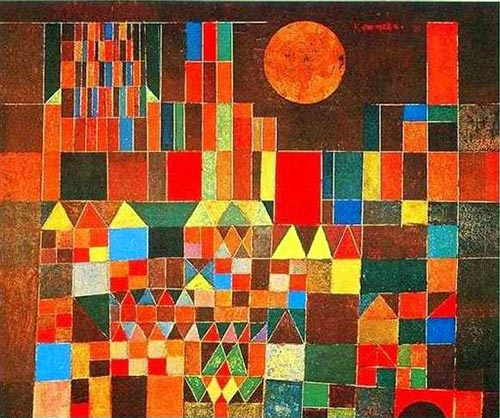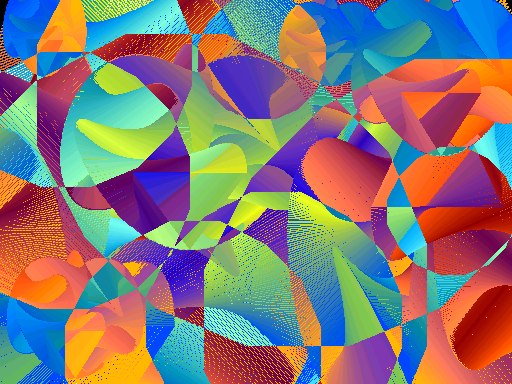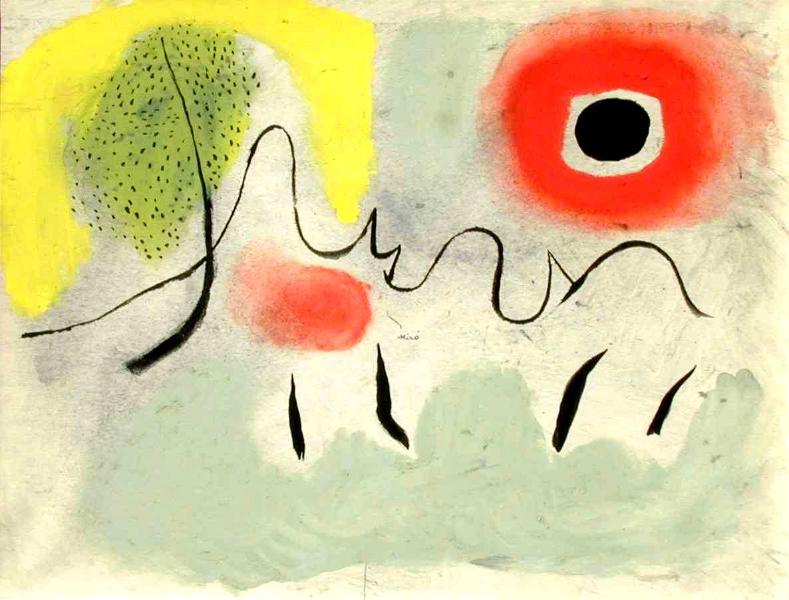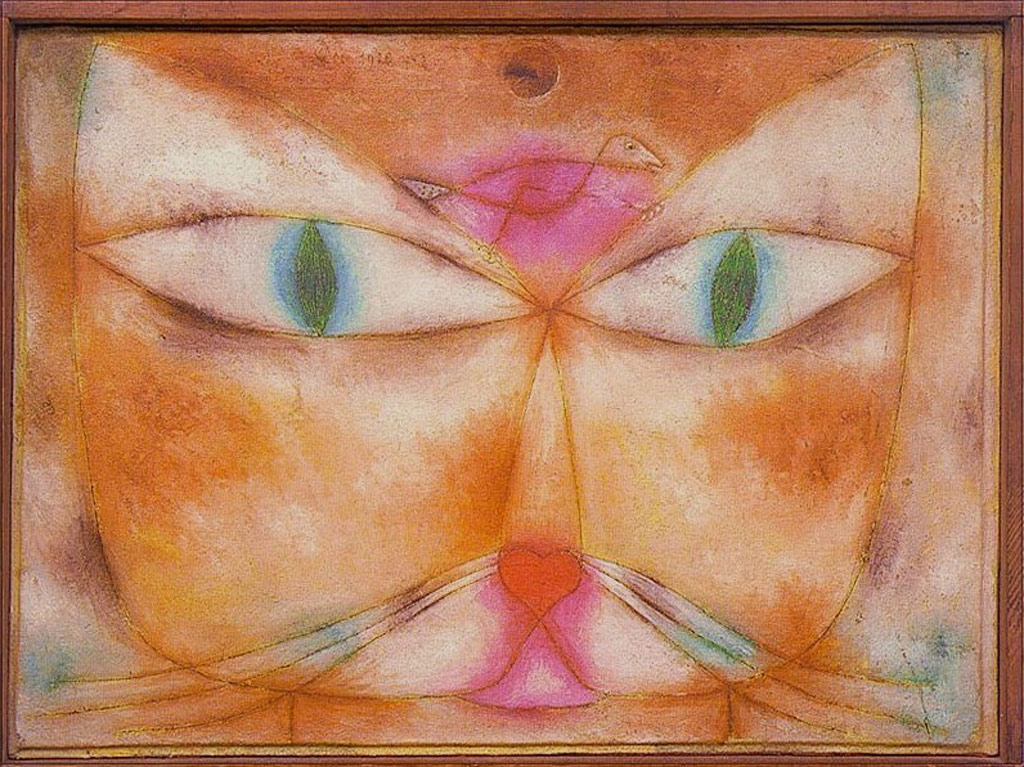<Back to Index>
- Physicist Christopher Polhem, 1661
- Painter Paul Klee, 1879
- Archduke of Austria-Este Franz Ferdinand, 1863
PAGE SPONSOR

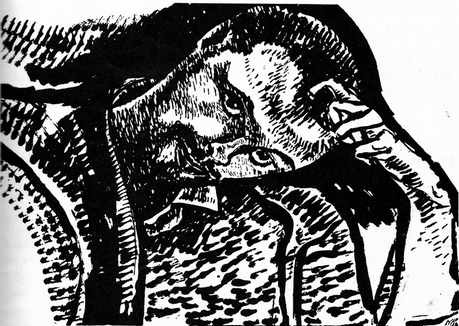
Paul Klee (18 December 1879 – 29 June 1940) was born in Münchenbuchsee, Switzerland, and is considered both a Swiss painter and a German painter. His highly individual style was influenced by movements in art that included expressionism, cubism, and surrealism. He was, as well, a student of orientalism. Klee was a natural draftsman who experimented with and eventually mastered color theory, and wrote extensively about it; his lectures Writings on Form and Design Theory (Schriften zur Form und Gestaltungslehre), published in English as the Paul Klee Notebooks, are considered so important for modern art that they are compared to the importance that Leonardo da Vinci's A Treatise on Painting had for Renaissance. He and his colleague , the Russian painter Wassily Kandinsky, both taught at the German Bauhaus school of art, design and architecture. His works reflect his dry humour and his sometimes childlike perspective, his personal moods and beliefs, and his musicality.
| “ | First of all, the art of living; then as my ideal profession, poetry and philosophy, and as my real profession, plastic arts; in the last resort, for lack of income, illustrations. | ” |
|
—Paul Klee. |
||
Klee was born in Münchenbuchsee (near Bern), Switzerland into a musical family. His father, Hans Klee, was a German music teacher at the Hofwil Teacher Seminar near Bern. His mother, Ida Frick, had trained to be a singer. He was the second of two children. Klee started young at both drawing and music. At age seven, he started playing the violin, and at age eight, he was given a box of sidewalk chalk by his grandmother. Klee appears to have been equally talented in music and drawing. In his early years, following his parents’ wishes, he focused on becoming a musician; but he decided on the visual arts during his teen years, partly out of rebellion and partly because of his belief that modern music lacked meaning for him. He stated, “I didn’t find the idea of going in for music creatively particularly attractive in view of the decline in the history of musical achievement.” As a musician, he played and felt emotionally bound to traditional works of the 18th and 19th century, but as an artist he craved the freedom to explore radical ideas and styles. At sixteen, Klee’s landscape drawings already show considerable skill.
Around
1897, he started his diary, which he kept until 1918, and which has
provided scholars with valuable insight into his life and thinking. During his school years, he
avidly drew in his school books, in particular drawing caricatures,
and already demonstrating skill with line and volume. He barely passed his final
exams at the “Gymnasium” of Bern, where he qualified in the Humanities.
With his characteristic dry wit, he wrote, “After all, it’s rather
difficult to achieve the exact minimum, and it involves
risks.” On
his own time, in addition to his deep interests in music and art, Klee
was a great reader of literature, and later a writer on art theory and aesthetics. With his
parents' reluctant permission, in 1898 he began studying art at the Academy of Fine
Arts in Munich with Heinrich Knirr and Franz von Stuck.
He excelled at drawing but seemed to lack any natural color sense. He
later recalled, “During the third winter I even realized that I
probably would never learn to paint.” During
these times of youthful adventure, Klee spent much time in pubs and had
affairs with lower class women and artists' models. He had an
illegitimate son in 1900 who died several weeks after birth. After
receiving his Fine Arts degree, Klee went to Italy from October
1901 to May 1902 with friend Hermann Haller.
They stayed in Rome, Florence, and Naples, and studied the master
painters of past centuries. He exclaimed, “The Forum and the Vatican have spoken to me. Humanism wants to suffocate me.” He responded to the colors of
Italy, but sadly noted, “that a long struggle lies in store for me in
this field of color.” For
Klee, color represented the optimism and nobility in art, and a hoped
for relief from the pessimistic nature he expressed in his
black-and-white grotesques and satires. Returning
to Bern, he lived with his parents for several years, and took
occasional art classes. By 1905, he was developing some experimental
techniques, including drawing with a needle on a blackened pane of
glass, resulting in fifty-seven works including his Portrait of My Father (1906). In the years 1903-5 he also
completed a cycle of eleven zinc plate etchings called Inventions, his
first exhibited works, in which he illustrated several grotesque
characters. He commented,
“though I’m fairly satisfied with my etchings I can’t go on like this.
I’m not a specialist.” Klee was still dividing his
time with music, playing the violin in an orchestra and writing concert
and theater reviews. Klee
married Bavarian pianist
Lily Stumpf in 1906 and they had one son named Felix Paul in the
following year. They lived in a suburb of Munich, and while she gave
piano lessons and occasional performances, he kept house and tended to
his art work. His attempt to be a magazine illustrator failed. Klee’s
art work progressed slowly for the next five years, partly from having
to divide his time with domestic matters, and partly as he tried to
find a new approach to his art. In 1910, he had his first solo
exhibition in Bern, which then traveled to three Swiss cities. The
following year, he did some illustrations for an edition of Voltaire’s Candide.
That year he met Wassily
Kandinsky, Franz Marc,
and other avant garde figures, and became associated
with the art group known as Der Blaue Reiter (The Blue Rider).
On
meeting Kandinsky, Klee recorded, “I came to feel a deep trust in him.
He is somebody, and has an exceptionally beautiful and lucid mind.” The association opened his mind
to modern theories of color. His travels to Paris in 1912 also exposed
him to the ferment of Cubism and the pioneering examples
of “pure painting”, an early term for abstract art.
The use of bold color by Robert Delaunay and Maurice de
Vlaminck also
inspired him. Rather
than copy these artists, Klee began working out his own color
experiments in pale watercolors and did some primitive landscapes,
including In the
Quarry (1913) and Houses
near the Gravel Pit (1913),
using blocks of color with limited overlap. Klee
acknowledged that “a long struggle lies in store for me in this field
of color” in order to reach his “distant noble aim.” Soon, he
discovered “the style which connects drawing and the realm of color.” Klee’s
artistic breakthrough came in 1914 when he briefly visited Tunisia with August Macke and Louis Moilliet and
was impressed by the quality of the light there. He wrote, "Colour has
taken possession of me; no longer do I have to chase after it, I know
that it has hold of me forever... Colour and I are one. I am a painter." With
that realization, faithfulness to nature fades in importance. Instead,
Klee began to delve into the “cool romanticism of abstraction”. In
gaining a second artistic vocabulary, Klee added color to his abilities
in draftsmanship, and in many works combined them successfully, as he
did in one series he called “operatic paintings”.
One of the most literal examples of this new
synthesis is The
Bavarian Don Giovanni (1919). After
returning home, Klee painted his first pure abstract, In the Style of Kairouan (1914), composed of colored
rectangles and a few circles. The
colored rectangle became his basic building block, what some scholars
associate with a musical note, which Klee combined with other colored
blocks to create a color harmony analogous to a musical composition.
His selection of a particular color palette emulates a musical key.
Sometimes he uses complementary pairs of colors, and other times
“dissonant” colors, again reflecting his connection with musicality. A few
weeks later, World War I began.
At first, Klee was somewhat detached from it, as he wrote ironically,
“I have long had this war in me. That is why, inwardly, it is none of
my concern.” Soon,
however, it began to affect him. His friends Macke and Marc both died
in battle. Venting his distress, he created several pen and ink lithographs on war themes including Death for the Idea (1915). He
also continued with abstracts and semi-abstracts. In 1916, he joined
the German war effort, but with behind the scenes maneuvering by his
father, Klee was spared serving at the front and ended up painting
camouflage on airplanes and working as a clerk. He
continued to paint during the entire war and managed to exhibit in
several shows. By 1917, Klee’s work was selling well and art critics
acclaimed him as the best of the new German artists. His Ab ovo (1917)
is particularly noteworthy for its sophisticated technique. It employs
watercolor on gauze and paper with a chalk ground, which produces a
rich texture of triangular, circular, and crescent patterns.
Demonstrating his range of exploration, mixing color and line, his Warning of the Ships (1918) is a colored drawing
filled with symbolic images on a field of suppressed color. In
1919, Klee applied for a teaching post at the Academy of Art in
Düsseldorf. This attempt failed but he had a major success in
securing a three year contract (with a minimum annual income) with
dealer Hans Goltz, whose influential gallery gave Klee major exposure,
and some commercial success. A retrospective of over 300 works in 1920
was also notable. Klee
taught at the Bauhaus,
the art school newly formed in 1919 to unite arts and crafts in one
institution, and to give each student “a thorough training in the
workshops of all branches”. Klee was a “Form” master in the
bookbinding, stained glass, and mural painting workshops. He was also
provided with two studios. In
1922, Kandinsky joined the staff and resumed his friendship with Klee.
Later that year the first Bauhaus exhibition and festival was held, for
which Klee created several of the advertising materials. Within
the Bauhaus there were many conflicting theories and opinions, which
Klee welcomed: “I also approve of these forces competing one with the
other if the result is achievement.” Klee was
also a member of Die Blaue Vier (The Blue Four), with Kandinsky, Feininger,
and Jawlensky;
formed
in 1923, they lectured and exhibited together in the USA in
1925. That same year, Klee had his first exhibits in Paris, and he
became a hit with the French Surrealists. Klee
visited Egypt in 1928, which impressed him less than Tunisia. In 1929,
the first major monograph on Klee’s work was published, written by Will
Grohmann. From
nearly the start, the Nazi movement denounced the Bauhaus for its "degenerate art"
and
in 1933 the Bauhaus was finally shut down. Emigrants did succeed,
however, in spreading the concepts of the Bauhaus to other countries,
including the “New Bauhaus” of Chicago. Klee also taught at the Düsseldorf Academy
from 1931 to 1933, and was singled out by a Nazi newspaper, “Then that
great fellow Klee comes onto the scene, already famed as a Bauhaus
teacher in Dessau. He tells everyone he’s a thoroughbred Arab, but he’s
a typical Galician Jew.” His home was searched by the Gestapo and he was fired from his
job. His self-portrait Struck from the List (1933)
commemorates the sad occasion. In
1933-4, Klee had shows in London and Paris, and finally met Picasso whom he greatly admired. The Klee family emigrated to
Switzerland in late 1933. Klee was
at the peak of his creative output. His Ad Parnassum (1932) is considered his
masterpiece and the best example of his pointillist
style; it is also one of his largest, most finely worked paintings. He produced nearly 500 works in
1933 during his last year in Germany.
However, in 1933, Klee began experiencing the symptoms of
what was diagnosed as scleroderma after
his death. The progression of his fatal disease, which made swallowing
very difficult, can be followed through the art he created in his last
years. His output in 1936 was only 25 pictures. In the later 1930s, his
health recovered somewhat and he was encouraged by a visit from
Kandinsky and Picasso. Klee’s
simpler and larger designs enabled him to keep up his output in his
final years, and in 1939 he created over 1,200 works, a career high for
one year. He
used heavier lines and mainly geometric forms with fewer but larger
blocks of color. His varied color palettes, some with bright colors and
others sober, perhaps reflected his alternating moods of optimism and
pessimism. Back
in Germany in 1937, seventeen of Klee’s pictures were included in an
exhibition of “Degenerate Art” and 102 of his works in public
collections were seized by the Nazis. Klee
suffered from a wasting disease, scleroderma,
toward
the end of his life, enduring pain that seems to be reflected in
his last works of art. One of his last paintings, "Death and Fire",
features a skull in the center with the German word for death, "Tod",
appearing in the face. He died in Muralto,
Locarno, Switzerland, on June 29, 1940 without having obtained Swiss
citizenship, despite his birth in that country. His art work was
considered too revolutionary, even degenerate, by the Swiss
authorities, but eventually they accepted his request six days after
his death. His legacy comprises about
9,000 works of art. The
words on his tombstone, Klee's credo, placed there by his son Felix,
say, "I cannot be grasped in the here and now, For my dwelling place is
as much among the dead, As the yet unborn, Slightly closer to the heart
of creation than usual, But still not close enough." He was buried at Schosshalde
Friedhof, Bern, Switzerland. Klee has
been variously associated with Expressionism, Cubism, Futurism, Surrealism,
and
Abstraction, but his pictures are difficult to classify. He generally
worked in isolation from his peers, and interpreted new art
trends in his own way. He was inventive in his methods and technique.
Klee worked in many different media — oil paint, watercolor, ink, pastel, etching,
and others. He often combined them into one work. He used canvas,
burlap, muslin, linen, gauze, cardboard, metal foils, fabric,
wallpaper, and newsprint. Klee employed spray paint,
knife application, stamping, glazing, and impasto, and mixed media such as oil with
watercolor, water color with pen and India ink, and oil with tempera. He
was a natural draftsman, and through long experimentation developed a
mastery of color and tonality. Many of his works combine these skills.
He uses a great variety of color palettes from nearly monochromatic to
highly polychromatic. His works often have a fragile child-like quality
to them and are usually on a small scale. He often used geometric forms
as well as letters, numbers, and arrows, and combined them with figures
of animals and people. Some works were completely abstract. Many of his
works and their titles reflect his dry humor and varying moods; some
express political convictions. They frequently allude to poetry,
music and dreams
and sometimes include words or musical notation.
The later works are distinguished by spidery hieroglyph-like
symbols. Rainer Maria
Rilke wrote
about Klee in 1921, “Even if you hadn’t told me he plays the violin, I
would have guessed that on many occasions his drawings were
transcriptions of music.” Pamela
Kort observed: "Klee's 1933 drawings present their beholder with an
unparalleled opportunity to glimpse a central aspect of his aesthetics that has remained largely
unappreciated: his lifelong concern with the possibilities of parody and wit.
Herein lies their real significance, particularly for an audience
unaware that Klee's art has political dimensions." As
Klee learned to manipulate color with great skill and passion, he
became an effective teacher of color mixing and color theory to
students at the Bauhaus.
This progression in itself is of great interest because his views on
color would ultimately allow him to write about it from a unique
viewpoint among his contemporaries. Klee
influenced the work of other noted artists of the early 20th century
including Belgian printmaker Rene Carcan. Composer Gunther Schuller immortalized seven works of
Klee's in his Seven
Studies on Themes of Paul Klee. The studies are based on a range of
works, including Alter
Klang [Antique Harmonies], Abstraktes
Terzett [Abstract Trio], Little
Blue Devil, Twittering
Machine, Arab
Village, Ein
unheimlicher Moment [An Eerie Moment], and Pastorale. The German Ensemble
Sortisatio together
with
the Swiss Groupe Lacroix worked on the project "8 Pieces on Paul
Klee", based on the work of the painter. Another Klee inspired work is Wingate's Second Symphony,
subtitled Kleetüden;
Variationen für Orchester nach Paul Klee (Variations for Orchestra
after Paul Klee) which
consists of 27 tone paintings in homage to Klee. The Spanish composer Benet
Casablancas's symphonic work Alter
Klang. Impromptu for orchestra after Klee, based on Klee's painting
of the same title, was commissioned by Orquesta
Nacional de España, which prémièred it in
2007 under the baton of Josep Pons. This is not the only piece by
Casablancas that is inspired by Klee; in 2007 he composed a chamber
cantata Retablo
sobre textos de Paul Klee, for soprano, mezzosoprano and piano,
commissioned by Fundación Canal in Madrid. One of
Klee's paintings, Angelus Novus,
was the object of an interpretive text by German philosopher and literary critic Walter Benjamin,
who
purchased the painting in 1921. In his "Theses on the Philosophy of
History," Benjamin suggests that the angel depicted in the painting
might be seen as representing the angel of history. In
1938 Steinway pianos manufactured the "Paul Klee series", to
commemorate the way in which Klee married the art forms of music and
visual art. Only 500 pianos were produced in this limited series, with
Vladimir Horowitz being one of those to purchase the piano. Paul Klee
described the series as "a great honour and privilege. This tribute has
affirmed my life's work." In the
late sixties, the psychedelic nature of Klee's pieces was revived
musically by a group (including jazz composer Chuck Mangione),
The National Gallery released the album Performing Musical
Interpretations of the Paintings of Paul Klee in 1968, with music and
lyrics that are appropriately surprising, strange, and delightful. Today, a
painting by Paul Klee can sell for as much as $7.5 million. A
museum dedicated to Paul Klee was built in Bern,
Switzerland, by the Italian architect Renzo Piano. Zentrum Paul
Klee opened
in June 2005 and houses a collection of about 4,000 works by Paul Klee.
Another substantial collection of Klee's works is owned by chemist and
playwright Carl Djerassi and displayed at the San Francisco
Museum of Modern Art.


